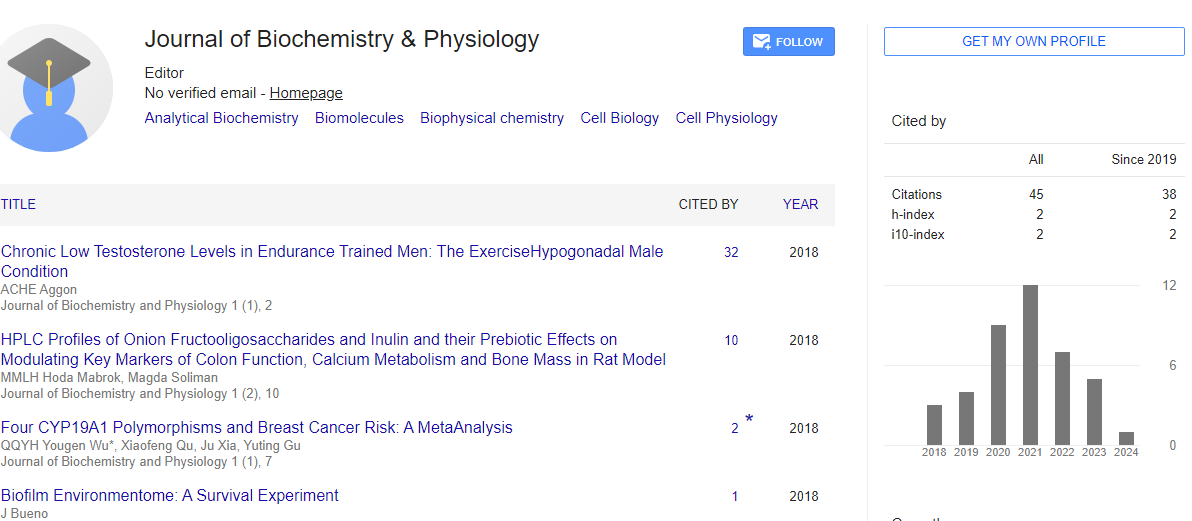Commentary, J Biochem Physiol Vol: 7 Issue: 3
Imaging Cellular Biochemistry: Techniques and Applications
Perry Tebo*
1Department of Cellular and Molecular Medicine, Boston Children's Hospital, Harvard Medical School, Boston, USA
*Corresponding Author: Perry Tebo,
Department of Cellular and Molecular
Medicine, Boston Children's Hospital, Harvard Medical School, Boston, USA
E-mail: teboper@y.edu
Received date: 19 August, 2024, Manuscript No. JBPY-24-139478;
Editor assigned date: 21 August, 2024, PreQC No. JBPY-24-139478 (PQ);
Reviewed date: 04 September, 2024, QC No. JBPY-24-139478;
Revised date: 12 September, 2024, Manuscript No. JBPY-24-139478 (R);
Published date: 19 September, 2024, DOI: 10.4172/jbpy.1000160.
Citation: Tebo P (2024) Imaging Cellular Biochemistry: Techniques and Applications. J Biochem Physiol 7:3.
Description
Imaging techniques are invaluable for visualizing cellular biochemistry, enabling scientists to explore the intricate and dynamic processes occurring within cells. Advanced imaging technologies provide insights into the spatial and temporal organization of biomolecules, interactions and biochemical pathways, leading to a better understanding of cellular function and disease mechanisms. Fluorescence microscopy is an essential of cellular imaging, relying on the ability of fluorophores to emit light upon excitation. These fluorophores can be attached to specific biomolecules, allowing visualization of their location and dynamics within cells.
Confocal microscopy uses point illumination and spatial filtering to enhance optical resolution and contrast. This technique provides highresolution images and 3D reconstruction of cellular structures by eliminating out-of-focus light. Total Internal Reflection Fluorescence (TIRF) microscopy enables visualization of events occurring at or near the cell membrane by exciting fluorophores within a thin evanescent field. This technique is particularly useful for studying membrane dynamics and receptor-ligand interactions. Techniques such as Stimulated Emission Depletion (STED), Photoactivated Localization Microscopy (PALM) and Stochastic Optical Reconstruction Microscopy (STORM) surpass the diffraction limit of light, achieving resolutions down to tens of nanometers. These methods allow detailed imaging of molecular complexes and cellular nanostructures.
Fluorescence Resonance Energy Transfer (FRET) is a powerful technique for studying molecular interactions and conformational changes. It relies on the transfer of energy between two closely positioned fluorophores, a donor and an acceptor. Changes in FRET efficiency reflect alterations in the distance or orientation between the fluorophores, providing insights into protein-protein interactions, enzyme activities and signaling events within live cells. Live-cell imaging captures dynamic processes in living cells over time, using time-lapse microscopy to monitor cellular events such as migration, division and intracellular trafficking. Combining live-cell imaging with fluorescence techniques allows researchers to observe the realtime behavior of biomolecules and cellular structures, offering insights into dynamic processes and their regulation. Multiphoton microscopy uses near-infrared light for the simultaneous excitation of multiple fluorophores, reducing photodamage and allowing imaging of deeper tissue sections.
This technique is ideal for studying thick biological samples and in vivo imaging, enabling visualization of cellular processes within their native environment. Electron Microscopy (EM) provides ultra-high resolution imaging of cellular structures. Transmission Electron Microscopy (TEM) and Scanning Electron Microscopy (SEM) offer detailed views of cellular ultrastructure and surface morphology, respectively. Recent advances, such as Cryo-EM, allow the imaging of biological macromolecules in near-native states, contributing to structural biology and the visualization of protein complexes. Atomic Force Microscopy (AFM) provides nanoscale topographical imaging and measures the mechanical properties of cellular components. AFM uses a sharp tip to scan the surface of a sample, generating detailed images of cellular structures and their physical properties.
Applications in cellular biochemistry
Imaging techniques have revolutionized the study of protein localization and dynamics within cells. Fluorescence microscopy allows the tracking of fluorescently tagged proteins, revealing their spatial distribution and movement. This is important for understanding the organization of cellular compartments, protein trafficking and the assembly of molecular complexes involved in signaling and metabolic pathways. Techniques such as FRET and live-cell imaging enable the study of intracellular signaling pathways by visualizing the interactions and activities of signaling molecules. These methods provide insights into the dynamics of signal transduction, the activation of second messengers and the modulation of cellular responses to external stimuli.
Imaging methods like TIRF microscopy and AFM are used to study membrane dynamics, including vesicle fusion, endocytosis and the organization of lipid rafts. These techniques shed light on how membranes regulate the transport of molecules, signal transduction, and interactions with the extracellular environment. EM, particularly Cryo-EM, has advanced structural biology by providing highresolution images of macromolecular complexes and their arrangements within cells. This has facilitated the determination of protein structures, interactions and conformational changes, contributing to drug discovery and the understanding of molecular mechanisms in diseases. Imaging techniques are employed to study cellular metabolism by visualizing metabolic enzymes, substrates and products.
Conclusion
Imaging techniques are essential tools for exploring cellular biochemistry, providing detailed visualizations of molecular and cellular processes. Advancements in fluorescence microscopy, FRET, live-cell imaging and electron microscopy have expanded our understanding of protein dynamics, intracellular signaling, membrane behavior and structural biology. These imaging methods continue to drive discoveries in cell biology, enabling researchers to uncover the complexities of cellular function and their implications for health and disease.
 Spanish
Spanish  Chinese
Chinese  Russian
Russian  German
German  French
French  Japanese
Japanese  Portuguese
Portuguese  Hindi
Hindi 